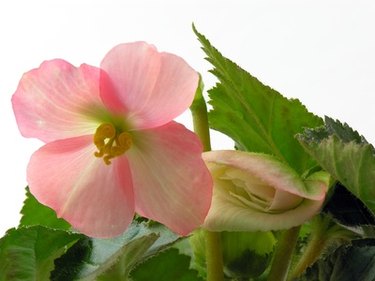
Begonias are well-known additions to the home garden for their season-long bloom and brilliant display of color. When pests take an interest in these blossoms, their feeding leads to cosmetic damage and health problems. Plagued by a variety of pests, your begonias do stand a good chance for a healthy life provided that they receive consistent, appropriate care. Grow begonias in partial shade and moist, well-drained soil.
Scale
Video of the Day
Scales are one of the most prominent pest problems on begonias, according to the Clemson University Extension. The green shield scale, a soft scale pest, targets begonia plants for feeding. Generally measuring up to approximately 1/4 inch in length, soft scales display round bodies in a light green hue, sometimes surrounded by their eggs that look like cotton. Scales are "sucking bugs" that feed on the inner tissue fluid of begonia plants, resulting in yellowed, wilted leaves that often drop early and potential growth problems.
Video of the Day
In addition, green shield scales produce honeydew as they eat, a sticky-sweet substance that drips on plant parts, encouraging the growth of sooty mold. Sooty mold is a black fungus that covers plant surfaces, blocking out necessary sunlight. Soft scales are controlled with the release of natural enemies like lady beetles or parasitic wasps. Effective chemical insecticides include horticultural oil and those with the active ingredient carbaryl, according to the University of California Integrated Pest Management Online.
Mealybug
Mealybug infestations are a prevalent problem among begonias. These pests are sucking bugs that also produce honeydew. The University of California IPM Online explains that the greatest amount of mealybug damage is attributed to sooty mold development. Measuring .05 to .2 inches in length, mealybugs are oval in shape, appearing spiky and commonly covered with a white, cotton-like material. Home growers should look for collections of the cottony material where mealybugs gather in groups. To prevent early leaf drop and dieback associated with this pest infestation, natural enemies like mealybug destroyers assist in control. Gardeners can also spray mealybugs from plant surfaces with water or apply horticultural oil as a means of chemical management.
Spider Mite
Spider mites are found on a wide variety of plants, causing a great deal of problems for begonias. These pests are sucking bugs that result in the appearance of tiny faded dots on leaf surfaces as well as leaves that discolor to a yellow or bronze hue before dropping from the begonia plant. In addition, as the name suggests, spider mites form webs on begonia surfaces, providing a means of distinguishing this pest from others. Gardeners can control spider mites by releasing the natural enemies western predatory mites or lacewings, according to the University of California IPM Online. Insecticidal soap is an effective chemical spray control as other pesticides can have an adverse effect and encourage mite populations.
Slugs
Slugs, or snails without their shells, are a problematic pest for begonia plants. Measuring 1/4 inch to several inches in length, slugs are slimy, black, brown, grey or orange muscle-like creatures that leave a path of slime behind them as they travel. Eating plant tissue of both young and mature plants, gardeners may notice holes in plant parts from feeding. To control these pests, gardeners can trap them by keeping cups in the ground filled with beer or a yeast and water mixture. Slugs are attracted to the liquid and drown in it. Culturally, slugs prefer moist environments, so gardeners should maintain good circulation among begonias and keep the area free of excess plant debris. For chemical control, slug bait attracts and poisons slugs. Bait is available at garden supply stores.
- Clemson University Extension: Begonia
- University of California IPM Online: Managing Pests in Gardens: Invertebrates: Mealybugs -- UC IPM
- University of California IPM Online: Scale Management Guidelines -- UC IPM
- University of California IPM Online: UC Management Guidelines for Soft Scales on Floriculture and Ornamental Nurseries
- University of California IPM Online: Spider Mites Management Guidelines -- UC IPM
- Ohio State University Extension: Slugs and Their Management
- University of California IPM Online: Managing Pests in Gardens: Floriculture: Begonias -- UC IPM